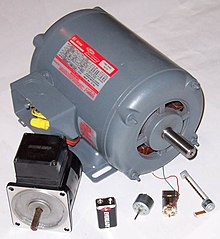Since relays are switches, the terminology applied to switches is also applied to relays. A relay will switch one or more poles, each of whose contacts can be thrown by energizing the coil in one of three ways:
- Normally-open (NO) contacts connect the circuit when the relay is activated; the circuit is disconnected when the relay is inactive. It is also called a Form A contact or "make" contact. NO contacts can also be distinguished as "early-make" or NOEM, which means that the contacts will close before the button or switch is fully engaged.
- Normally-closed (NC) contacts disconnect the circuit when the relay is activated; the circuit is connected when the relay is inactive. It is also called a Form B contact or "break" contact. NC contacts can also be distinguished as "late-break" or NCLB, which means that the contacts will stay closed until the button or switch is fully disengaged.
- Change-over (CO), or double-throw (DT), contacts control two circuits: one normally-open contact and one normally-closed contact with a common terminal. It is also called a Form C contact or "transfer" contact ("break before make"). If this type of contact utilizes a "make before break" functionality, then it is called a Form D contact.
- SPST – Single Pole Single Throw. These have two terminals which can be connected or disconnected. Including two for the coil, such a relay has four terminals in total. It is ambiguous whether the pole is normally open or normally closed. The terminology "SPNO" and "SPNC" is sometimes used to resolve the ambiguity.
- SPDT – Single Pole Double Throw. A common terminal connects to either of two others. Including two for the coil, such a relay has five terminals in total.
- DPST – Double Pole Single Throw. These have two pairs of terminals. Equivalent to two SPST switches or relays actuated by a single coil. Including two for the coil, such a relay has six terminals in total. The poles may be Form A or Form B (or one of each).
- DPDT – Double Pole Double Throw. These have two rows of change-over terminals. Equivalent to two SPDT switches or relays actuated by a single coil. Such a relay has eight terminals, including the coil.
EN 50005 are among applicable standards for relay terminal numbering; a typical EN 50005-compliant SPDT relay's terminals would be numbered 11, 12, 14, A1 and A2 for the C, NC, NO, and coil connections, respectively.
[edit] Applications
Relays are used to and for:- Amplify a digital signal, switching a large amount of power with a small operating power. Some special cases are:
- A telegraph relay, repeating a weak signal received at the end of a long wire
- Controlling a high-voltage circuit with a low-voltage signal, as in some types of modems or audio amplifiers,
- Controlling a high-current circuit with a low-current signal, as in the starter solenoid of an automobile,
- Detect and isolate faults on transmission and distribution lines by opening and closing circuit breakers (protection relays),
- Isolate the controlling circuit from the controlled circuit when the two are at different potentials, for example when controlling a mains-powered device from a low-voltage switch. The latter is often applied to control office lighting as the low voltage wires are easily installed in partitions, which may be often moved as needs change. They may also be controlled by room occupancy detectors to conserve energy,
- Logic functions. For example, the boolean AND function is realised by connecting normally open relay contacts in series, the OR function by connecting normally open contacts in parallel. The change-over or Form C contacts perform the XOR (exclusive or) function. Similar functions for NAND and NOR are accomplished using normally closed contacts. The Ladder programming language is often used for designing relay logic networks.
- The application of Boolean Algebra to relay circuit design was formalized by Claude Shannon in A Symbolic Analysis of Relay and Switching Circuits
- Early computing. Before vacuum tubes and transistors, relays were used as logical elements in digital computers. See electro-mechanical computers such as ARRA (computer), Harvard Mark II, Zuse Z2, and Zuse Z3.
- Safety-critical logic. Because relays are much more resistant than semiconductors to nuclear radiation, they are widely used in safety-critical logic, such as the control panels of radioactive waste-handling machinery.
- Time delay functions. Relays can be modified to delay opening or delay closing a set of contacts. A very short (a fraction of a second) delay would use a copper disk between the armature and moving blade assembly. Current flowing in the disk maintains magnetic field for a short time, lengthening release time. For a slightly longer (up to a minute) delay, a dashpot is used. A dashpot is a piston filled with fluid that is allowed to escape slowly. The time period can be varied by increasing or decreasing the flow rate. For longer time periods, a mechanical clockwork timer is installed.
- Vehicle battery isolation. A 12v relay is often used to isolate any second battery in cars, 4WDs, RVs and boats.
- Switching to a standby power supply.





 ERICO® is dedicated to providing the best Penangkal Petir solution for any given application, whether this involves the use of
ERICO® is dedicated to providing the best Penangkal Petir solution for any given application, whether this involves the use of